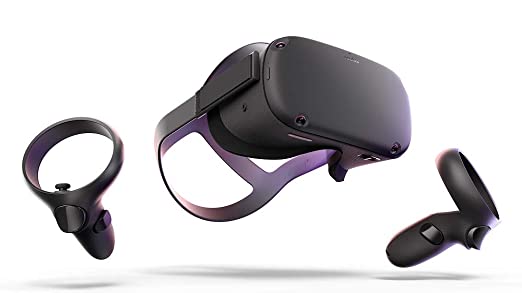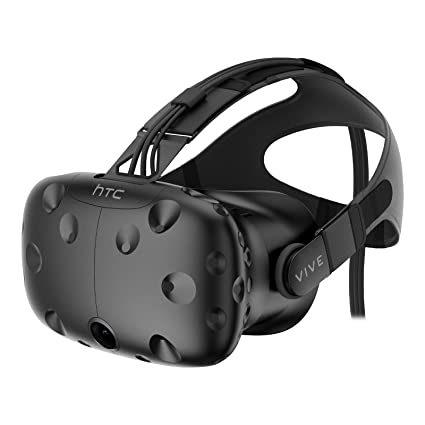Oculus Quest vs HTC VIVE
When you compare the Oculus Quest to the HTC VIVE you can see which VR Headset is better. Let's take a look of the comparison, and see which model of VR Headset out ontop.
What VR Headset is better?
When it comes to comparing virtual reality headsets, the two most popular and widely used models are the Oculus Quest and HTC VIVE. Both headsets offer immersive experiences with top-notch features, allowing users to explore virtual worlds from their own home. In this comparison, I will be looking at various features and specifications of both devices in order to provide an honest overview for anyone interested in investing in a VR headset.
The first specification we'll look at is field of view. The Oculus Quest offers a slightly narrower field of view than the HTC VIVE with 95° versus 110°. While this may seem like a con on paper, I personally felt that the slightly narrower field of view provided by the Oculus Quest created more of an immersion effect due to its design being focused more around mobile gaming rather than large living room environments. This allows players to feel more enclosed when exploring virtual worlds which can create a great sense of presence within them.
The next specification we'll consider is resolution; here we have quite different specs between both devices; 1600 × 1440 px for the Oculus Quest compared to 1080 × 1200 px for the HTC VIVE. When it comes to visuals within VR games and applications, higher resolutions generally lead to better visual fidelity and sharper images however in my experience both headsets did an admirable job providing clear visuals even when running graphically demanding titles such as Half-Life: Alyx or Beat Saber. Ultimately what matters most is how these resolutions impact your personal preferences, so if you have access to both units it's worth trying out each one before making your decision based on whether you prefer clarity over immersion or vice versa.
Both headsets feature 360 tracking but there are some differences here too; while both offer 6DOF tracking capabilities allowing players full freedom of movement throughout their respective environments - something which is integral for creating immersive experiences - only the HTC Vive supports SteamVR Tracking 2.0 technology which helps reduce motion sickness experienced during intense movements by lowering latency rates significantly compared other existing tracking technologies on the market today.
Lastly let's take a look at refresh rate; with 90 Hz vs 72 Hz respectively, this could again seem like another disadvantage for the Oculus Quest but upon testing both devices side-by-side I didn't notice any significant difference between them regarding juddering or lag related issues thus suggesting that perhaps refresh rate isn't as important as it may initially appear when talking about premium VR experiences unless you're using extremely intensive applications such as those specifically designed for professional use cases where data accuracy needs to be incredibly precise such as architecture visualization apps etc...
To summarize my thoughts on these two high-end pieces of equipment: overall they share many similar specs however what really sets them apart would be their pricing points (the HTC VIVE being slightly pricier) along with platform support (Oculus Quest being standalone while needing external hardware setup if wanting play PC based content). Personally speaking I preferred using either one depending on what type activity was going perform whether that was playing mobile games via standalone mode or experiencing larger scale graphical projects through external PCs – both were equally enjoyable so ultimately it just depends on your own preference & budget when considering which device might best suit your specific needs & desires regarding Virtual Reality experiences!
Specs comparison between the two VR Headsets
| Oculus Quest | HTC VIVE | |
|---|---|---|
| Overview | ||
| Brand | Meta | HTC |
| Model Name | Quest | VIVE |
| Release Date | 2019 | 2016 |
| Country of Origin | United States | Taiwan |
| Category | Standalone VR | PC VR |
| Battery Life | 3 h | 2.5 h |
| Display | ||
| Field of View | 95° | 110° |
| Resolution | 1600 × 1440 px (per eye) | 1080 × 1200 px (per eye) |
| Refresh Rate | 72 Hz | 90 Hz |
| Display Type | OLED | OLED |
| Minimum Requirements | ||
| Min. CPU Required | Intel i5-4590 or AMD Ryzen 5 1500X or greater | Intel I5-4590 or AMD FX 8350 |
| Min. Graphics Required | Nvidia Titan X GTX 1060 or GTX 1070 or RTX 20 series | Nvidia GeForce™ GTX 1060 or AMD Radeon™ RX 480 |
| Min. RAM Required | 8 GB | 4 GB |
| Operating Systems | Microsoft Windows | Microsoft Windows |
| Sizing | ||
| Weight | 571 g | 470 g |
| Dimensions | 190.5 x 104.14 x 114.3 mm | 199 × 122 × 122 mm |
| Features | ||
| Room Scale? | YES | YES |
| 360 Tracking? | YES | YES |
| Positional Tracking? | YES | YES |
| Front Camera? | No | YES |
| Eye Tracking? | No | |
| Usable with Glasses? | YES | YES |
| Cooling System | YES | No |
| Built in Headphones? | YES | No |
| Built in Microphone? | YES | YES |
| Flip Visor? | YES | YES |
| Voice Command? | YES | YES |
| IPD Adjustment? | YES | YES |
| Lens to Eye Adjustment? | No | YES |
| USB? | YES | YES |
| MicroUSB? | no | No |
| Display Port? | YES | YES |
| Mini Display Port? | No | No |
| HDMI? | No | YES |
| MicroSD? | No | YES |
| Bluetooth? | YES | YES |
| Wifi? | YES | YES |

